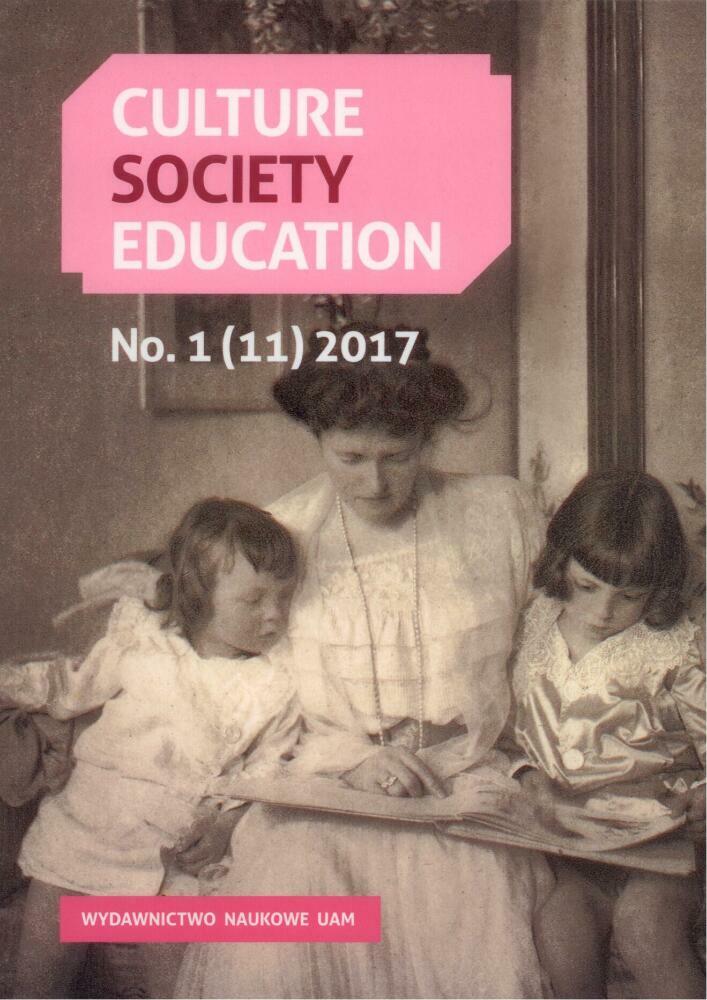Abstract
The accommodation of children and young people of foreign descent to new life conditions and educational challenges abroad is a process that takes place primarily in the context of social interactions. The aim of the article below is to present selected experiences in terms of integrating schoolchildren of Polish origin in Germany. The author considers the presentation of school space as an integration microcosm of its own to be of particular importance. It is worth noting that the German educational system in the present form often discriminates against schoolchildren of foreign descent and limits the opportunities for further education. The author’s own empirical verifications served as the research illustration in the text. The verifications, though carried out on a small sample, indicate some timeless trends among young Polish immigrants.
Literaturhinweise
Babka von Gostomski Ch. (2010). Fortschritte der Integration. Zur Situation der fünf größten in Deutschland lebenden Ausländergruppen. Im Auftrag des Bundesministeriums des Innern, Forschungsbericht 8. Nürnberg.
Bade, K.J. (2007). Integration: Versäumte Chancen und nachholende Politik, „Aus Politik und Zeitgeschichte“, Heft 22-23, pp. 32-38, quoted after: Filsinger D. (2008). Bedingungen erfolgreicher Integration – Integrationsmonitoring und Evaluation. Expertise. Bonn.
Bahlmann M. (2000). Aussiedlerkinder – ein (sonder-)pädagogisches Problem? Münster.
Bera R. Korczyński M. (2012). Dystans społeczny emigrantów polskich wobec „obcych” i „innych”. Lublin.
Chutnik M. (2007). Szok kulturowy. Przyczyny. Konsekwencje. Przeciwdziałanie. Kraków.
Cichocki, P. Götz M., Jarosz A., Nowosielski M., Kubiak P., Skrzypczak J., Tujdowski M. (2011). Polacy w Niemczech. Raport z badania. Ekspertyza Instytutu Zachodniego z 01/2011. Poznań.
Dietrich E., Köller R., Koopmans R., Höhne J. (2011). Zweiter Integrationsindikatorenbericht – erstellt für die Beauftragte der Bundesregierung für Migration, Flüchtlinge und Integration. Köln/Berlin.
El-Mafaalani A., Toprak A. (2011). Muslimische Kinder und Jugendliche in Deutschland Lebenswelten – Denkmuster – Herausforderungen. Berlin.
Fatyga B. (1997). Młodzi Polacy i Niemcy w kontakcie międzykulturowym. [In:] U progu wielokulturowości. Nowe oblicza społeczeństwa polskiego. Ed. M. Kempny, A. Kapciak, S. Łodziński. Warszawa, pp. 148-149.
Filsinger D. (2008). Bedingungen erfolgreicher Integration – Integrationsmonitoring und Evaluation. Expertise. Bonn.
Foroutan N. (2015). Die Einheit der Verschiedenen: Integration in der postmigrantischen Gesellschaft. „Kurzdossier Focus Migration“, No. 28, pp. 1-8.
Kawczyńska-Butrym Z. (2009). Migracje. Wybrane zagadnienia. Lublin.
Kuszak K. (2014). Historia i współczesność zapisane w języku. „Kultura–Społeczeństwo–Edukacja”, No. 2 (6), pp. 39-56.
Kwiecień M. (2015). Polityka imigracyjna Niemiec. „Studia Ekonomiczne. Zeszyty Naukowe Uniwersytetu Ekonomicznego w Katowicach”, No. 211, pp. 79-96.
Nowosielski M. (2012), Polacy w Niemczech. Stan i perspektywy badań. „Przegląd Zachodni”, No. 3, pp. 3-27.
Pozorska M. (2008). Aktualne problemy integracji dzieci i młodzieży pochodzenia obcego w Niemczech na przykładzie sytuacji polskich imigrantów, a typescript of the master’s thesis. Poznań.
Sauer K. E. (2007). Integrationsprozesse von Kindern in multikulturellen Gesellschaften. Wiesbaden.
Schymura I. (2015). Zweisprachigkeit, Schulerfolg und Integration von Migrantenkindern mit polnischsprachigem Hintergrund, a typescript of the doctoral dissertation. Essen.
Segeš Frelak J.( 2012). Polska migracja zarobkowa do Niemiec po 2004 roku. [In:] Znikająca zagranica. Nowa polska migracja do Niemiec – perspektywa lokalna. Ed. A. Łada, J. Segeš Frelak. Warszawa, pp. 17-31.
Siegert M. (2008). Schulische Bildung von Migranten in Deutschland, Reihe „Integrationsreport“, Teil 1: Working Paper 13. Nürnberg.
Sowińska H. (2002). Procesy integracyjne w klasie szkolnej. [In:] Konteksty edukacji zintegrowanej. Ed. H. Sowińska, E. Misiorna, R. Michalak. Poznań 2002, pp. 93-95.
Stanat P., Rauch D., Segeritz M. (2010). Schülerinnen und Schüler mit Migrationshintergrund. [In:] PISA 2009. Bilanz nach einem Jahrzehnt. Red. E. Klieme, C. Artelt, J. Hartig, N. Jude, O. Köller, M. Prenzel, W. Schneider, P. Stanat, Münster/New York/München/Berlin, pp. 200-230.
Statistisches Bundesamt (2015a). Bevölkerung und Erwerbstätigkeit – Bevölkerung mit Migrationshintergrund – Ergebnisse des Mikrozensus, Fachserie 1 Reihe 2.2. Wiesbaden.
Statistisches Bundesamt (2016a). Bevölkerung und Erwerbstätigkeit – Ausländische Bevölkerung – Ergebnisse des Ausländerzentralregisters, Fachserie 1 Reihe 2. Wiesbaden.
Stempin A. (2013). Niemiecki model polityki integracyjnej. „Kultura i Polityka: Zeszyty Naukowe Wyższej Szkoły Europejskiej im. ks. Józefa Tischnera w Krakowie”, No. 13, pp. 56-70.
Wagner J. (1991). Freundschaften und Freundschaftsverständnis bei drei- bis zwölfjährigen Kinder. Berlin.
Internet sources
Bade K.J. (2013), Als Deutschland zum Einwanderungsland wurde, http://www.zeit.de/gesellschaft/zeitgeschehen/2013-11/einwanderung-anwerbestopp (access: 27.03.2016).
German Marshall Fund of the United States (2014), Transatlantic trends 2014: mobility, migration and integration, http://trends.gmfus.org/immigration-2014/ (access: 25.05.2016).
LPB-BW (2009), PISA, IGLU, OECD-Jahresberichte und Ländervergleich der KMK-Bildungsstandards, https://www.lpb-bw.de/pisa.html (access: 27.03.2016).
German Marshall Fund of the United States (2014), Transatlantic trends 2014: mobility, migration and integration, http://trends.gmfus.org/immigration-2014/ (access: 25.05.2016).
Huddleston T. Bilgili Ö., Joki A.-L., Vankova Z. (2015), Migrant Integration Policy Index (2015), http://www.mipex.eu/ access (27.03.2016).
MAIS des Landes NRW (2016), Integracja osób pochodzenia polskiego w Nadrenii Północnej-Westfalii. Wyciąg z 4. opatrzonej komentarzem statystyki ds. imigracji i integracji w Nadrenii Północnej-Westfalii, https://www.msz.gov.pl/resource/bdbdc2b2-2f18-4825-a8a5-aadcd0a8fd50:JCR (access: 27.03.2016).
Matzke M. (2015), Raport: Niemcy robią postępy w integracji cudzoziemców, http://www.dw.com/pl/raport-niemcy-robi%C4%85-post%C4%99py-w-integracji-cudzoziemc%C3%B3w/a-18507227 (access: 25.06.2016).
Metzner I.D. (2012), W Niemczech żyją imigranci ze 194 państw świata, http://www.dw.com/pl/w-niemczech-%C5%BCyj%C4%85-imigranci-ze-194-pa%C5%84stw-%C5%9Bwiata/a-16462700 (access:05.04.2016).
Nowosielski M. (2009), Kondycja polskich i polskojęzycznych organizacji w Niemczech, ”Biuletyn Instytutu Zachodniego”, nr 19, http://www.iz.poznan.pl/news/96_nr%2019.%20Polacy%20w%20Niemczech.pdf (access: 28.05.2014).
PAP (2016), Rząd Niemiec przyjął projekt ustawy o integracji imigrantów, http://www.polskieradio.pl/5/3/Artykul/1623772,Rzad-Niemiec-przyjal-projekt-ustawy-o-integracji-imigrantow (25.06.2016).
Scholz K.-A., Dudek B. (2012), Szczyt Integracyjny: Uczestniczymy w przekształcaniu Niemiec w państwo imigracyjne, http://www.dw.com/pl/szczyt-integracyjny-uczestniczymy-w-przekszta%C5%82caniu-niemiec-w-pa%C5%84stwo-imigracyjne/a-15707077 (27.03.2016).
Statista (2008), Schüler mit und ohne Migrationshintergrund in Deutschland nach Schulform, http://de.statista.com/statistik/daten/studie/156911/umfrage/schueler-mit-und-ohne-migrationshintergrund-2008-schulform/ (access: 27.03.2016).
Statistisches Bundesamt (2015b), Zahl der Zuwanderer in Deutschland so hoch wie noch nie, https://www.destatis.de/DE/PresseService/Presse/Pressemitteilungen/2015/08/PD15_277_122.html;jsessionid=FD501CC5E1A15E1463B2EE823D80F40E.cae3 (access: 27.03.2016).
Statistisches Bundesamt (2016b), Nettozuwanderung von Ausländerinnen und Ausländern im Jahr 2015 bei 1,1 Millionen, https://www.destatis.de/DE/PresseService/Presse/Pressemitteilungen/2016/03/PD16_105_12421.html (access: 27.03.2016).
Szaniawska-Schwabe M. (2009), Polityka imigracyjna Republiki Federalnej Niemiec, „Przegląd Zachodni”, nr 4, http://iz.poznan.pl/plik,pobierz,1104,b007effdeb82b77f9ffad58c076559b4/4-2009-4-wybrany-art.pdf (access: 15.05.2016).
Lizenz
Copyright (c) 2017 Magda Kalkowska

Dieses Werk steht unter der Lizenz Creative Commons Namensnennung - Keine Bearbeitungen 4.0 International.
